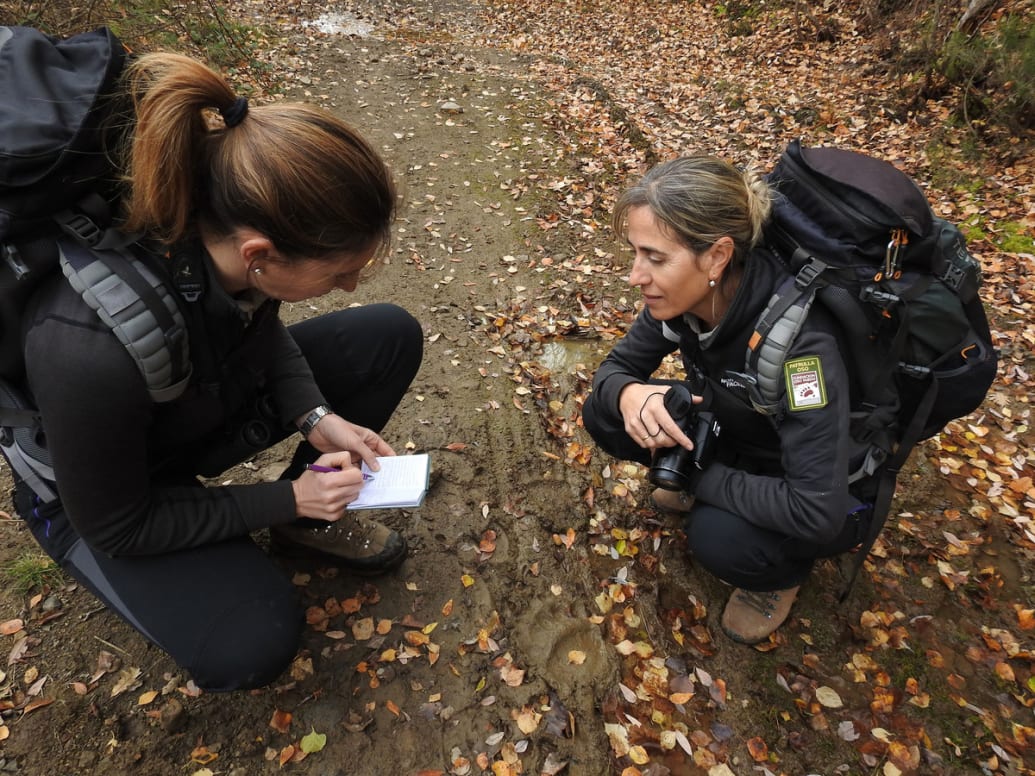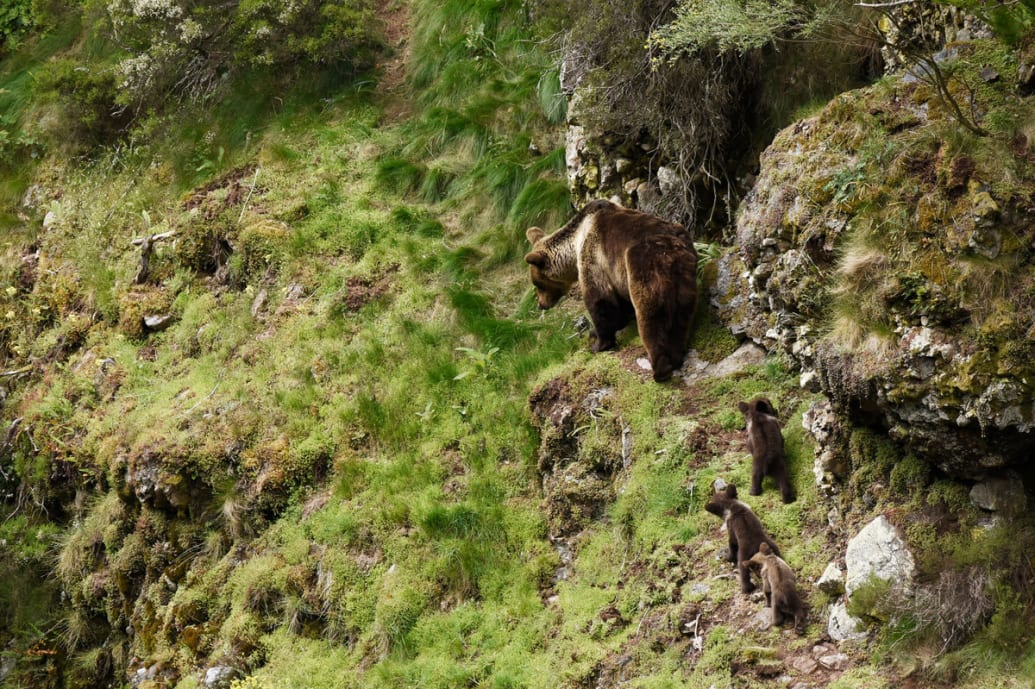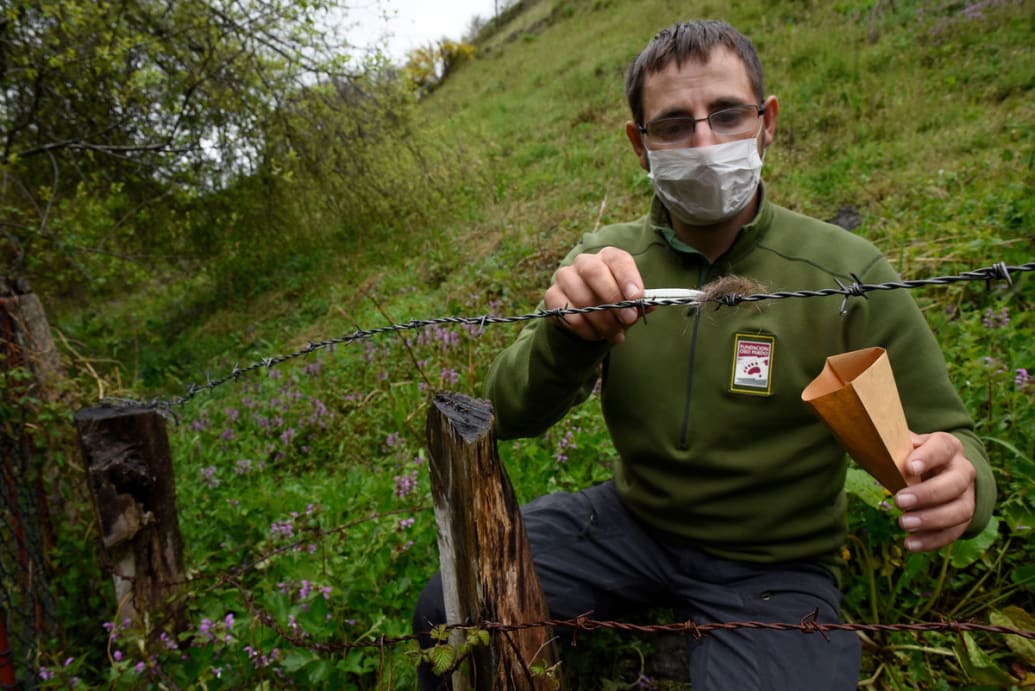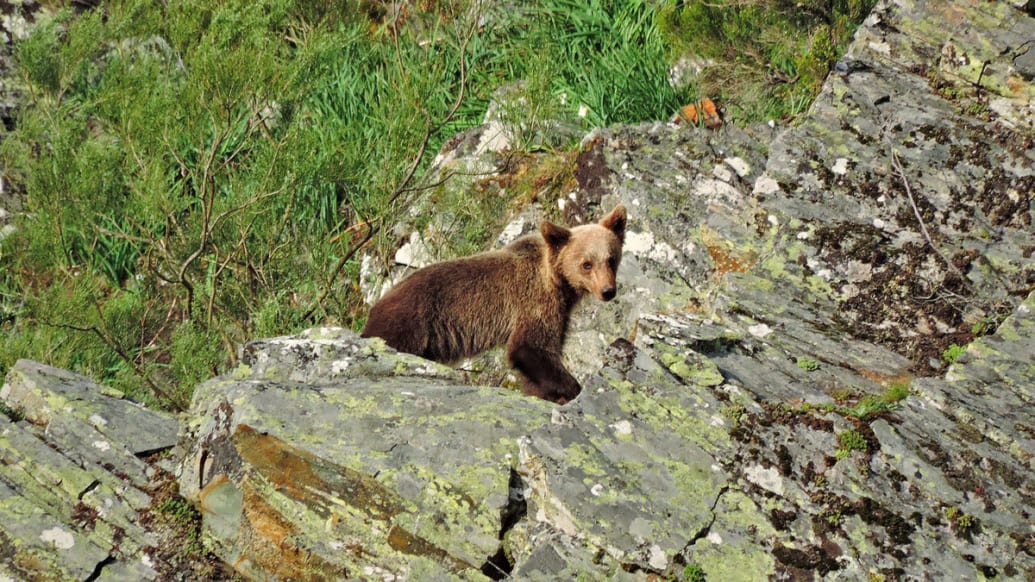[ad_1]
What’s the gown code for a bear hunt? In two phrases: nothing fancy. The packing checklist supplied by the journey company left no room for doubt: I used to be to carry “strong sneakers for strolling, with coated toes,” and “gentle layers, waterproofs and a heat coat.”
So there’d be mountain climbing concerned, and the local weather may be variable, presumably damp. However then there was the color-coding. My wardrobe for the journey was to be primarily based on “earth and foliage colours” with “brilliant patterns or flashy supplies that can’t be present in nature” strictly prohibited. So perhaps the Ibiza clubwear may be de trop.
For weeks I’d been telling anybody who’d hear about my upcoming journey in the hunt for bears. A few of my homosexual pals smirked at me, however I used to be well past seeing the humorous aspect of their smutty innuendoes. Few issues make me happier than the prospect of seeing uncommon creatures of their pure habitat, and the truth that this appeared to be potential in Spain, the comparatively crowded and extremely touristed nation the place I’ve lived for 30+ years, solely added to the fun.
On the six-hour practice experience from Madrid to Asturias, I watched the boring plains of Castile billow up into folds of mountainside draped with thick vegetation and, on the best peaks, glittering shreds of the 12 months’s final snow. Such is Spain’s range, and its biodiversity, that even a brief journey can carry you into a completely completely different world.
Beast Journey Digest
Get the whole world in your inbox.
Asturias is among the 4 “autonomous areas” ranging alongside the Cantabrian coast from Galicia to the Basque Nation, and an enclave that holds a particular place within the hearts of true Hispanophiles. Asturias considers itself the historic nucleus of what was to finally turn into Spain: it’s right here that the Muslim push northwards was repelled on the battle of Covadonga in 722AD, paving the best way for the Catholic Reconquest. A guidelines of the salient factors of Asturian tradition would possibly embody: a novel language generally known as bable; a wealthy heritage of pre-Romanesque structure from the sixth to ninth centuries; a ribsticking regional delicacies; cheese, of which this a veritable paradise; and cider, made and drunk right here in nice amount. Oviedo, the delightfully buttoned-up little capital metropolis, was famously praised to the skies by none apart from Woody Allen. However for me the area’s excellent characteristic are its landscapes, that are as wild and wooly as wherever in Europe and as well-preserved. Asturias incorporates seven Biosphere Reserves and at least a 3rd of its territory enjoys some form of safety.
At Oviedo railway station I joined a bunch organized by Steppes Journey and nature-tourism outfit Wild Spain Journey in collaboration with Fundación Oso Pardo (FOP), the Spanish NGO working since 1992 to place Spain’s endangered brown bear inhabitants on the street to restoration. Additionally in attendance was British millionaire philanthropist Paul Lister, whose European Nature Belief (TENT) helps a spread of big-deal conservation initiatives throughout the continent—together with the FOP. It’s Lister’s perception that conservation teams must be making extra noise within the media concerning the essential work they do—therefore my presence on this firm.
I’ve a way that for North People bears loom bigger within the psyche than they do for us Europeans. From the U.S. and Canada come the scary, nature-red-in-tooth-and-claw tales of campers being savaged of their tents. Bears in Hollywood movies are typified by that scene in The Revenant through which Leo di Caprio is comprehensively carried out over by an enormous grizzly, doing for bears what Jaws did for sharks. The European brown bear is analogous in dimension and morphology to its American cousin, having the identical thick coat of tough hair in various tones of brown, grey and black, the identical highly effective haunches and big paws, and the identical fluffy-edged ears that dare you to name them cute. However homegrown Spanish bear lore is far much less high-drama. You would possibly see a narrative on the TV information: one thing a couple of bear shot by a poacher, or a sighting in a populated space. Or it may be a beekeeper, up in arms a couple of bear blundering into their hives and stealing all of the honey. In any other case, the query of bears impinges little on one’s consciousness.
In order we sped south into the deep countryside, I used to be grateful to Luis Frechilla of WST for giving me the bear information. (Warning: this text could comprise traces of unhealthy puns on the phrase ‘bear.’)
Bears exist in varied European international locations–notably Finland, Romania, and Slovenia–and have been as soon as discovered throughout Spain’s mountainous areas. However by 1973, when the species Ursos arctros cantabricus was lastly protected beneath Spanish legislation, fewer than 60 brown bears remained, corralled within the Cantabrian mountains of the north. Genetic range was more and more compromised because the remaining populations turned remoted from one another. Ecologists feared the worst. “We nervous that the bear would not final till the millennium,” remembered Frechilla.
Half a century later the established order has taken a radical flip.
A mixture of watertight environmental safety, habitat restoration, scientific analysis, and outreach amongst native communities—most of this work undertaken by the Fundación Oso Pardo—has caused one thing near a miracle. Greater than 400 bears now roam the mountains of Asturias and neighboring provinces of Cantabria and Palencia, and the quantity continues to develop at a charge of 10-15 % year-on-year. The FOP’s “bear corridors” shaped by new plantations of fruit bushes have introduced disparate populations into contact, strengthening the gene pool. For as soon as then the information is all good. Certainly, the return of Ursus arctos cantabricus is a heartening success-story in a world that desperately wants extra of them.

Members doc a bear monitor.
Fundacion Oso Pardo
The tour’s first cease was the Parque Pure Fuentes del Narcea Degaña e Ibias, a nature reserve within the far southwestern nook of Asturias. The Parque Pure holds inside it the much more rigorously protected Reserva Integral de Muñiellos, considered one of Europe’s largest expanses of major oak forest and a main habitat for otters, wildcats, wolves—and bears. Wooden from Muñiellos was used to construct the Spanish Armada, however in contrast to most of Spain’s previously wild areas it has remained in its pristine state. It says one thing about this treasured place that simply 20 guests a day are allowed to enter the 14,752-acre reserve.
Victor García, one other of the Wild Spain Journey guides, led the group alongside the one permitted route by the Reserva Integral. Together with his strong body and rubicund face, it struck me García may be one other instance of individuals coming to resemble the animals they love. He was born and grew up within the hamlet of Tabrau, on the coronary heart of the Fuentes del Narcea reserve, and noticed his first bear at age six. “I used to be with my father up within the hills when he handed me the binoculars. ‘Check out this,’ he mentioned.” It was the start of a ravishing friendship—however even ten years in the past, when García started his profession as a nature information, beginner bear-spotting was very a lot in its infancy. “You needed to be very, very freaky to be a bear-watcher,” he confided as we walked.
As spring turned to summer season the Asturian countryside felt worlds aside from the dusty heats of the Spanish south. Snow-melt rivers rushed alongside deep valleys blanketed in fifty shades of inexperienced. The luxurious pastures of Muñiellos have been dense with wildflowers. Alongside the valley path García stopped to look at a holly tree that somebody, or one thing, had snapped on the stem. Most definitely a bear in search of berries, he mused. I felt a shiver; we have been getting nearer to our quarry. Additional down the monitor, the bark of a silver birch bore claw marks in 5 parallel strains the place some zealous male had tagged his territory.
That night we drove up into the mountains and our first lookout web site, on the rim of a wooded valley reverse the craggy cliffs of La Penona. Circumstances have been perfect, mentioned the guides. Spring and summer season have been mating time, and the bears’ blood was up. “At the moment the bears are extra enthusiastic about intercourse than meals. They’re in all places proper now,” mentioned García cheerfully.

An grownup Cantabrian bear with three cubs.
Fundacion Oso Pardo
All over, apart from right here. The guides scanned the mountainsides with their highly effective Kowa and Nikon telescopes, which have fluorite lenses and a spread of half a mile or extra. We waited, anticipated. However there was nothing doing–it appeared that tonight we have been out of luck. The solar dipped behind a cloud, casting a sudden chill. I used to be glad I’d introduced my Goretex jacket in these unflattering ‘earth and foliage’ colours.
It was an inauspicious begin to my bear safari, and I started to have creeping doubts. Would this be like that whale-watching journey within the Canary Islands just a few years again once I managed to identify a dolphin or two, however the remainder was a whale of a disappointment? Going residence empty-handed once more, with the embarrassment of ‘fessing as much as my pals that I’d seen nothing–properly, it didn’t ‘bear’ fascinated by.
Then all of a sudden it was lights, digital camera, motion. “I’ve bought one,” whispered Luis Frechilla in a voice charged with urgency. I hovered behind him, anticipating a glimpse. When my flip got here to look by the viewfinder a rush of adrenaline pumped by my veins, all my powers of consideration concentrating themselves on two small patches of darkish brown transferring throughout the barren mountain maybe a half-mile away. It was a big male pursuing a feminine by the rocks and scrub, each of them lumbering together with stunning velocity for a creature that may weigh in at greater than 500 kilos.
After the adrenaline rush got here delight and reduction. I watched the chase sequence up there on the hill till the nightfall got here down, and for the remainder of the night time I used to be excessive on the second. Now all the pieces I noticed was bear-related. Checking into my room at Casa Ponce, a 250-year-old village home within the hamlet of Posada de Rengos, I famous the time-blackened picket beams and the creaky staircase resulting in my attic room beneath the eaves. It was as if Goldilocks had gone into enterprise with the Three Bears and opened her personal nation inn.
Over breakfast Yazmin Cabrera, a Mexican who had married one of many Asturian house owners of Casa Ponce, informed me bear-spotting had all the time been a distinct segment exercise on this neck of the woods, however that she had famous an uptick in recent times. If a few of her neighbors had initially been suspicious of this novelty, its worth to the native financial system—name it the bear market—was turning into clear even to essentially the most recalcitrant locals. I remembered what Frechilla had informed me concerning the across-the-board financial impression of bear tourism, estimated at 20 million euros, in these northern Spanish territories.

A member of the Fundacion Oso Pardo collects hair from a fence for evaluation.
Fundacion Oso Pardo
Fuentes del Narcea just isn’t the realm of Asturias that has benefited most from wildlife conservation, nevertheless. Within the Parque Pure de Somiedo, one other of the area’s spectacular nature reserves, Ursus arctros cantabricus has successfully breathed new life right into a group that was withering on the vine, hollowed out by emigration and a chronically low birth-rate. At a gathering with the mayor of Pola de Somiedo, diminutive capital of the reserve, I discovered that Somiedo now has 90-odd companies interfacing with nature-based tourism, up from zero in 1988 when the park was created. The rise within the variety of bears in Somiedo, from 5 in 1988 to 65 at current, was mirrored by the expansion within the human inhabitants. The village faculty now had 45 pupils, mentioned the mayor proudly; the inhabitants was regular at 1200 after years of decline. In my walks across the village I noticed bear motifs—on the promotional poster for a brand new house block, on flyers for bear-watching excursions, even on my carton of locally-sourced mineral water—testifying to the facility of conservation to result in social and financial change.
Now we headed to an commentary web site excessive within the distant Valle de Lago at 4245 ft above sea degree. One other golden night, one other valley-side viewpoint, and one other eyeful of Asturian surroundings. Somiedo’s crags and peaks of quartzite and sandstone, hovering above dense beech and oak woods, jogged my memory how little accustomed we Europeans are to wilderness of this scale and vacancy. With an estimated ratio of 4.6 inhabitants per sq. kilometer, human presence within the reserve is scant certainly. In truth the valleys’ huddles of thatched stone huts appeared to me extra like pure extrusions of the panorama than something created by the hand of man.
The group was silent, tense with focus, hunched over the telescopes. The immense wall of inexperienced reverse me was so breathtaking I might have gazed at it for hours, bears or no bears. I handed the time observing, by binoculars, a herd of untamed goats placidly grazing on the best slopes. The bear is the star of those mountains, nevertheless it shares the stage with wolves, one other beforehand endangered and now fêted Spanish species, in addition to roe deer, wildcats, and massive birds of prey just like the Egyptian vulture, considered one of which was simply now swooping throughout the distant view.
As soon as once more there was an pressing whisper, this time from Juan Carlos Blanco, biologist with the FOP. He had noticed a feminine means up on a dizzying crag far above the tree-line. She was a mature bear, colored a dun brown with a line of graying hairs alongside her again. What was she doing up there on the hill? Most likely steering away from marauding males, mentioned Blanco. It seems feminine bears are nature’s personal model of feminist empowerment. They dwell solitary lives, copulate once they really feel the urge, and finally turn into pregnant because of a course of referred to as “delayed implantation” which permits births to happen when assets are ample.
The group was quietly abuzz with excited chatter. “The place’s she going?” “She’s transferring to the left.” “She’s heading for that patch of yellow broom.” “She’s attractive!” She was certainly attractive—however there was extra magnificence coming proper up. A way behind the feminine, tumbling and rollicking, seemingly oblivious to the teetering precipice slightly below, have been her two month-old cubs. It transpired that this was one of many 27 new bear households to have been detected in Asturias this season. What I used to be seeing was basically the way forward for the species.

If in many of the world nature is in speedy retreat on the advance of humanity, right here was a uncommon exception. Because the brown bear extends its vary among the many Cantabrian mountains, sightings at the moment are potential inside half an hour’s drive from Oviedo. However this in itself brings issues that can want resolving. Throughout my Asturian journey I heard tales of bears that had ventured down into village orchards to gorge on cherries, elevating hackles among the many populace, or had found the banquet of free meals to be present in trash cans. Outdoors the city of Proaza, a mere 17 miles from the capital, I noticed simply accessible commentary websites the place a dozen or extra bear vacationers had gathered, some utilizing social media and walkie-talkies to trace down their prize. Earlier than lengthy some measure of regulation could also be referred to as for, mentioned Victor García, if bears and people are to take care of their present state of delicate equilibrium.
Now the cubs are sprawled over their mom, snoozing, lazing within the final rays of the night solar. It’s an image of nature’s resilience—not a lot “pink in tooth and claw” as nonchalantly getting on with the enterprise of survival. Squinting by the telescope I discover my imaginative and prescient is momentarily blurred. And it’s not only a careless contact of the large Nikon’s ultrasensitive focus wheel, however a tear that has welled up on the nook of my eye.
‘On the Path of Bears in Northern Spain’, a seven-night journey with Steppes Travel and the European Nature Belief, prices $3266. Contains meals, Wild Spain Journey guides, and a donation to the Fundación Oso Pardo.
[ad_2]
Source link


Recent Comments